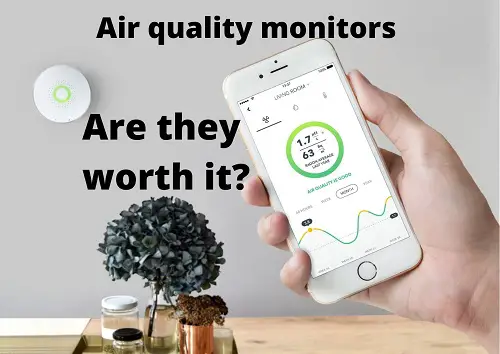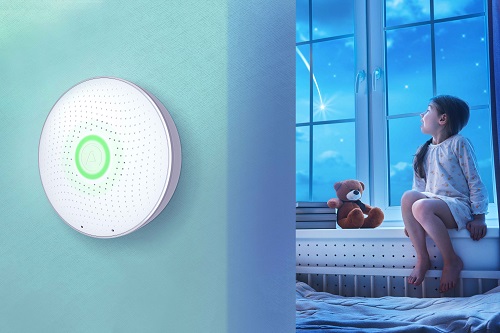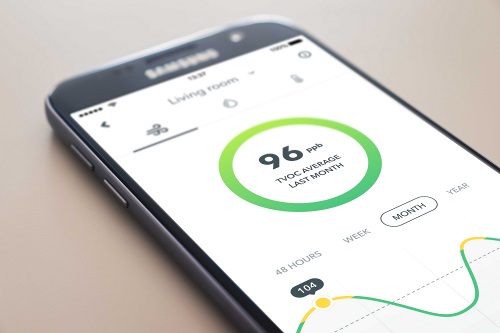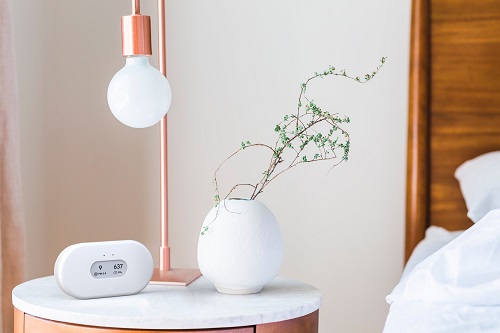Air quality monitors are absolutely worth it, especially if you have kids since they are more vulnerable to air pollutants. Air quality monitors help create the most healthy and comfortable home by detecting up to 6 harmful compounds as well as temperature and humidity. This allows you to take action based on data and knowledge, such as increasing ventilation, changing cleaning habits, relocating your air purifier, or purchasing a dehumidifier.

This article includes the following topics that you can jump to by clicking on their titles:
- Why measuring air quality is important for our health
- My personal experience with poor air quality (high CO2 levels)
- Reasons why an air quality monitor is worth it
- Good air quality is especially important for kids
- Air quality monitors help with allergens
- The benefites of using an air quality monitor
- In what areas do air quality monitors lack?
- These four compounds are a must to measure
- Air quality monitors do not clean the air or show where pollutants are coming from
- What is included when purchasing an air quality monitor?
- How much does an air quality monitor cost?
- Why use an air qualiy monitor instead of an air purifier?
- Knowing your air quality helps inform your actions
- How accurate are commercial air quality monitors?
- Conclusion: is an air quality monitor worth it?
Why measuring air quality is so important for our health
The quality of the air that we breathe has a significant effect on our health and wellbeing. Poor air can lead to many health issues, trigger allergies, or even cause illness and death in extreme cases. Going into nature is often mentioned as a great way of getting some fresh air. On the other hand, city air is commonly known to be somewhat, or even heavily, polluted.
However, according to the United States Environments Protection Agency (US EPA), indoor air is often 2 to 5 times more polluted than outdoor air (source). This happens because many air pollutants are caused by human activity plus the fact that indoor areas often trap air. Because of this, air pollutants that enter our indoor air will be trapped and build up to potentially harmful levels.
There are many different compounds that can build up in our indoor air. These compounds can make the air unhealthy to breathe and can lead to a range of health issues and complaints. Air quality related symptoms include:
- irritation of the eyes, nose, or throat
- headaches
- dizziness
- fatigue
- increased symptoms of asthma or any other respiratory illnesses
Before we are able to improve our health by improving indoor air quality, we need to know what the condition of our air is. Therefore, measurements are required. A commercial air quality monitor is an excellent tool for measuring common indoor air pollutants that can greatly affect our health.
If you want to read more about common air pollutants, their health effects, and what you can do about them, I recommend reading my article: The complete indoor air quality guide for your home.
My personal experience with poor air quality (high CO2 levels)
During my environmental sciences studies, we had a course on air quality. I was enthusiastic to learn, among others, how car exhaust reacts with the air and what its health effects are. However, no matter how fresh and eager me and my classmates were at the start of the lecture, we would always quickly feel tired and sleepy.
One day, we learned enough about air quality that we figured the classroom air might be the cause of our tiredness. Because of this, our teacher brought an air quality monitor to see whether we were right. And yes, the monitor measured normal CO2 levels at the start but saw a rapid increase in CO2 during the lecture. The levels of CO2 quickly rose to above 2000 ppm, which is exceptionally high. Symptoms associated with these levels of CO2 are, to no-ones surprise, sleepiness, poor concentration, and loss of attention.
Based on our measurements we adjusted the ventilation settings and made sure to open doors and windows. And just like that, our complaints went away.

Reasons why an air quality monitor is worth it
It is worth it to be able to measure the air quality for every room in your house and make a plan to create the most healthy air possible based on this data.
It is especially worth it if you have either:
- kids, since they are more vulnerable to air pollutants
- respiratory issues (often worsened by poor air quality)
- allergies (many allergies trigger off of particles in the air)
- are working on your house and want to make sure you’re breathing healthy air
- want to create the most healthy indoor environment possible
- want to geek out over the data
Good air quality is especially important for kids
Children are more susceptible to indoor air pollutants than adults. This is the case because they have relatively large lungs compared to their size in comparison to adults. Therefore, they inhale more air and thus pollutants per kilogram of body weight than adults.
Additionally, children’s airways are narrower than adults, so irritation and swelling of the airways can result in relatively greater airway blockage. This leads to children being more at risk of the effects of air pollution in comparison to adults.

Air quality monitors help with allergens
Allergies related to air quality are triggered by either:
- airborne particles such as dust
- mold spores
- pollen
- dust mites excrements and bodies
An air quality monitor makes sure that you are always notified of an increase in allergy-causing compounds. this allows you to take action immediately, such as airing out the house, improving ventilation, cleaning, or removing potential sources of particles.
The benefits of using an air quality monitor
Using an air quality monitor to measure the quality of the air in your home has many benefits. These include:
- Detecting what and how many air pollutants are in your air
- Detecting compounds that cannot be detected by sight, smell or taste
- Shows exactly how your air is doing
- Temperature, humidity, and pressure are measured
- Helping detect mold growth
- Allowing you to take action based on data and knowledge
- Helps create the most healthy and comfortable home
- An air quality monitor knows more than an air purifier
- Commercial air quality monitors are very accurate and easy to operate
For detailed information about these benefits, I recommend reading my article: Air quality monitors pros and cons.

In what areas do air quality monitors lack?
Air quality monitors, although having many advantages, are lacking in a few aspects. These are:
- A limited number of compounds can be measured
- Air quality monitors do not clean the air
- They do not show the source of the pollutants
- Most air quality monitors do not measure carbon monoxide (CO)
- Air quality monitors require up to 7 days to calibrate
These four compounds are a must to measure
The specific compounds that can be measured differ greatly between the type and brand of the monitor. Therefore, you need to be very careful when selecting a monitor that you wish to purchase. I highly recommend choosing a monitor that at least measures the following compounds:
- Particulate matter (PM2.5), also known as fine dust
- Volatile organic compounds (VOCs)
- Carbon dioxide (CO2)
- Radon gas (if applicable to your area)
These four compounds are among the most common air pollutants and can have a significant effect on your health. Radon gas is an outlier since it is either naturally present in your area, or it is not. If it is common in your area, you need to always be aware of it. You can find out more about Radon gas and look at the Radon map in my article: What is Radon? (origin, health risk, and preventive measures).
For the other compounds, PM2.5, VOCs, and CO2: these are the most common indoor air pollutants. You can take measures against PM2.5 and VOCs by purchasing a good air purifier. Ventilating and airing out the house more often helps reduce all three.
For a complete list of all the compounds that can be measured by air quality monitors, you can read my article: These compounds can be detected by air quality monitors – a complete list plus examples.
Air quality monitors do not clean the air or show where pollutants are coming from
They simply show how much of the compounds they can measure are in your air. With the exception of some additional features, they do nothing else. This means that you won’t learn where these pollutants are coming from and your monitor will also not help make the air cleaner.
If you need help determining where your air pollutants are coming from, I recommend reading my article: This is what causes your poor indoor air quality.
Some air quality monitors offer a few extra features that help detect for example mold growth. You can read more about this function in my article: Do air quality monitors detect mold? (this one can).
What is included when purchasing an air quality monitor?
Modern commercial air quality monitors are small, sleek, handheld devices that run on batteries. The average monitor weighs about 200 grams and is approximately 5x2x1.5 inches (13x5x4 cm) in size. They include the monitor, batteries, a charging cable, and a user manual.
The following tables show the specification of a variety of different air quality monitors that I recommend. Table 1 shows what they can measure and table 2 shows their specification such as price, weight, and size.
By using the links in the tables, you will be sent to either amazon.com or the Airthings store. By using these links to the Airthings store, you will get a 10% discount when using the coupon code: 665381-10OFF at checkout.
| Air quality monitor | Gives an indication of your air quality (good, medium, poor) | Particulate matter (pm) | VOCs/ TVOC | Separate indicator of formalde- hyde* | CO | CO2 | Radon gas | Temp- erature | Humidity | Air pressure |
|---|---|---|---|---|---|---|---|---|---|---|
| Airthings Wave Plus | ✓ | ✓ | ✓ | ✓ | ✓ | ✓ | ✓ | |||
| Airthings View Plus | ✓ | ✓ | ✓ | ✓ | ✓ | ✓ | ✓ | ✓ | ||
| BIAOLING | ✓ | ✓ | ✓ | ✓ | ✓ | ✓ | ||||
| Huma-i black (HI-150) | ✓ | ✓ | ✓ | ✓ | ✓ | ✓ | ||||
| Temtop M10 | ✓ | ✓ | ✓ | ✓ |
*Note that an air quality monitor that doesn’t display the presence of formaldehyde specifically does still measure it by measuring VOCs. It does not give specific data on formaldehyde but shows the total of all VOCs present in your air, including formaldehyde (often referred to as TVOC).
| Air quality monitor | Price | Battery life | Advanced features | Size | Weight |
|---|---|---|---|---|---|
| Airthings Wave Plus | $229 | 16 months | Sends data to a phone app + pollen levels | 4.7 x 1.4 in (12 x 3.6 cm) | 219 g |
| Airthings View Plus | $299 | 12 months | Sends data to a phone app + pollen levels | 6.7 x 3.5 x 1.3 in (17 x 9 x 3.3 cm) | 360 g |
| BIAOLING | $76 | 8-12 hours, rechargeable | 5.8 x 2.8 x 1.2 in (15 x 7 x 3 cm) | 218 g | |
| Huma-i black (HI-150) | $149 | unknown | 3.6 x 1.6 x 1.5 in (9 x 4 x 3.8 cm) | 60 g | |
| Temtop M10 | $96 | 6 hours | 3 x 3 x 1.2 in (8 x 8 x 3 cm) | 200 g |
How much does an air quality monitor cost?
On average, a commercial handheld indoor air quality monitor costs $136. Their price ranges from $15 to $350 depending on what compounds they can measure and the presence of extra features. A $15 monitor can measure one or two aspects of the air, while monitors from $75 and up can measure up to 9 different compounds and conditions of the air.
There are much more expensive air quality monitors available online. These, however, are mostly meant for industrial, outdoor use.
Why I prefer air quality monitors over air purifiers
Although an air purifier is a wonderful tool, ventilation is still your best weapon against indoor air pollution. Therefore, measuring the air with a good air quality monitor and ventilating when necessary is an excellent alternative to an air purifier.
An air quality monitor has the advantage over an air purifier in that it tests for more compounds than an air purifier can remove. For example, an air quality monitor informs you about the presence of carbon dioxide and radon. An air purifier does not and cannot remove these compounds from the air.
A regular air purifier can remove:
- particulate matter (fine dust)
- pollen
Air purifiers with a gas filter such as activated carbon help remove:
- VOCs
- Odors
Even though air purifiers help remove the abovementioned compounds, you will never know what exactly is present in your air. For example, if you have air quality related problems, they might be caused by high humidity and CO2 build-up. An air purifier will do you no good in this situation. It can even be harmful since it requires you to lower ventilation for optimal performance. In this situation, this will lead to worse air quality problems. If you want to read more about the disadvantages of air purifiers, you can read my article here.

Knowing your air quality helps inform your actions
Indoor air quality is on average 2 to 5 times worse than outdoor air and can be up to 100 times more polluted (source). Therefore, it is very likely that you will benefit from using an air quality monitor to know how your air is doing. This will help choose the necessary actions that need to be taken to improve your air, and therefore your health. So, assuming you have an air quality monitor and the first measurements are in. What action can you take to improve your air quality?
Elevated levels of CO2: You likely have poor ventilation. Therefore, fresh air is not able to replenish oxygen and lower CO2 levels. You should consider checking your HVAC system for clogging, changing the filters, or changing its settings. Additionally, you should check whether you have additional ventilation options that you are not using such as ventilation grilles above windows. Additionally, you should consider airing out the room more often and opening a window when you are present for longer periods of time.
Elevated levels of fine dust (particulate matter, pm2.5): Fine dust has many causes such as traffic, smoking, pet dander, candles, and dust cooking. Therefore, reducing fine dust can be difficult. Ventilation and airing out the house remain the most important actions you can take to reduce fine dust. On top of that, you should consider purchasing an air purifier. These are specifically designed to remove (fine dust) particles from the air. For more information, please read my article: How to know if you need an air purifier.
Elevated levels of VOCs: VOCs are mostly man-made compounds. They can be very dangerous but some are harmless. The most common sources of VOCs are paints (the typical paint smell), cleaning agents, deodorizers, glues, and resins. The best way to tackle VOCs is to prevent them from entering your home. This means purchasing low-VOCs paints, using natural cleaning products, and not mixing them,
Elevated levels of CO: Carbon monoxide (CO) is a very dangerous gas that is released from the (incomplete) burning of fuels. It cannot be detected by sight, smells, or taste and can lead to suffocation, drowning out oxygen. However, most air quality monitors do not measure carbon monoxide (CO). This has a good reason since CO should be measured by a separate device. CO needs to be measured constantly and at a height of 5 feet (1.5 m) from the ground. Since air quality monitors are not specifically used for CO measurements, their readings are less reliable than actual CO monitors. If you have elevated levels of CO, you should leave the house immediately and get as much fresh air as you can. The house should be thoroughly aired out and the source needs to be eliminated.
Elevated levels of radon gas: Radon gas is a dangerous natural gas that is not present everywhere in the world. Therefore, if you live in an area that is known for the presence of radon gas, you should measure for it constantly. If you have increased levels of radon you should contact a professional to take measures against it. You can read all about radon in my article: What is radon (origin, health risk, and preventive measures).
How accurate are commercial air quality monitors?
How do we know that the readings on our air quality monitor are accurate? To be exactly sure how accurate the readings are, extensive testing is needed. For example, we could test several commercial monitors versus a very accurate expensive scientific monitor. Another option would be to take several of the exact same monitors and measure the same air. If they measure about the same, they seem to be accurate.
I found a study by the Mackintosh Environmental Architecture Research Unit in 2018 that tested several cheap (<$200) commercial monitors versus an expensive scientific one. It said the following:
The findings suggest that low-cost monitors, . . . , have the potential to identify high pollutant exposures and to provide high-density, reliable, temporal data…
Mackintosh Environmental Architecture Research Unit (source)
Next to that, I found information about the Airthings air quality monitors that said they are accurate within 10% of the actual levels in the first week of use. After that, they become more accurate with a maximum of 5% deviation.
I took a deep dive into air quality monitor accuracy. You can read about what I learned in my article: How accurate are commercial air quality monitors?
Conclusion: is an air quality monitor worth it?
Good-quality commercial air quality monitors have become affordable at $100-$300. Additionally, They are almost as accurate as expensive scientific monitors. With the host of knowledge and benefits they provide for improving our and our children’s health, they are absolutely worth it.
Get a 10% discount on Airthings air quality monitors
I managed to arrange a discount for people reading my website! By using this link to the Airthings discount store you will get access and a 10% discount when entering this coupon code: 665381-10OFF.
In my opinion, the best overall air quality monitor is the Airthings View Plus, you can purchase it here with 10% discount when using the coupon code above at checkout.

